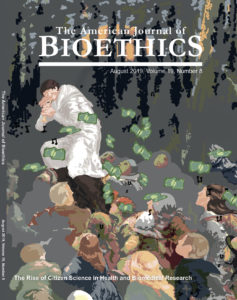by Bray Patrick-Lake MD, MSC & Jennifer C. Goldsack MS, MBA
The target article by Wiggins and Wilbanks reports on the history and typology of the models of citizen science emerging in health and biomedical research with the rapid dispersion and repurposing of technology. Wiggins and Wilbanks describe the variety of models through which nonprofessionals collaborate in the generation of health and biomedical knowledge, and highlight the benefits of these citizen science models.
It is inspiring to see the power of citizen science recognized. Wiggins and Wilbanks argue that the benefits can be substantial, acknowledging patient communities’ ability to identify interesting and highly relevant questions, accelerate the pace of research and new knowledge, and engage research participants in highly effective ways. However, the breadth of the “ethics gap” Wiggins and Wilbanks describe is alarming. Legal and regulatory protections for the patients championing this new field of health and biomedical research have not kept pace with the transition of the science—and risk—out of the clinic and into the hands of individuals.
 The 1991 Federal Policy for the Protection of Human Subjects (the Common Rule), was revised in 2017 and amended in January 2018 following a lengthy process that began with Advance Notice of Proposed Rulemaking in 2011. In 2016, the National Academies of Sciences, Engineering, and Medicine (NASEM) put out a bold call for Congress to withdraw the notice of proposed rulemaking to revise Common Rule. After months of evidence gathering and public workshops, which included input from citizen scientists, NASEM recommended that Congress authorize and the president appoint an independent national commission to examine and update the ethical, legal, and institutional frameworks governing research involving human participants. The report recognized the changing research landscape and transfer of risk to the individual and stated that the commission should make recommendations for how the ethical principles governing human subjects research should be applied to better protect participants in this new era.
The 1991 Federal Policy for the Protection of Human Subjects (the Common Rule), was revised in 2017 and amended in January 2018 following a lengthy process that began with Advance Notice of Proposed Rulemaking in 2011. In 2016, the National Academies of Sciences, Engineering, and Medicine (NASEM) put out a bold call for Congress to withdraw the notice of proposed rulemaking to revise Common Rule. After months of evidence gathering and public workshops, which included input from citizen scientists, NASEM recommended that Congress authorize and the president appoint an independent national commission to examine and update the ethical, legal, and institutional frameworks governing research involving human participants. The report recognized the changing research landscape and transfer of risk to the individual and stated that the commission should make recommendations for how the ethical principles governing human subjects research should be applied to better protect participants in this new era.
The revised Common Rule began to take effect in 2018 in direct opposition to the recommendations of NASEM and the calls of many of the stakeholders impacted by the policy. While several changes to the Common Rule undoubtedly benefit patients—promoting informed consent forms that quickly and clearly communicate key information to research participants, expediting minimal risk studies, and improving efficiency through mandating the use of single institutional review boards—these changes are at best incremental adjustments to an ossified system and, at worst, woefully inadequate for protecting participants in today’s rapidly evolving digital world and the era of citizen science in health and biomedical research.
Given the rise of citizen science in health and biomedical research and the ethics gap described by Wiggins and Wilbanks, how can we move quickly to protect individuals contributing to this new era of knowledge generation?
We must act immediately to address the ethics gap created by this new era of health and biomedical research. Our approach to developing a modern-day ethical framework should be as democratized and collaborative as the new models of citizen science themselves. We must include stakeholders developing the technologies that are powering the rise of nonprofessional contributors and co-creators of new health and biomedical knowledge. We must make transformational change.
To expedite the development of solutions to bridge the ethical gap, we should start by reviewing existing frameworks and resources and build upon them. The Belmont Report is the cornerstone upon which the Common Rule is built. In 2012, the U.S. Department of Homeland Security issued the Menlo Report, modeled on the Belmont Report and expanded to include the unique ethical challenges arising in research of or involving information and communication technology (ICT). I Am The Cavalry, a grass-roots initiative from the cybersecurity research community, has published the first Hippocratic Oath for Connected Medical Devices (HOCMD), containing five principles rooted in “do no harm” for developers of many of the technologies powering citizen science in health and biomedical research. We should also support and raise awareness of initiatives already underway. An example is ReCODE Health, a research center for optimal digital ethics in health that is shaping responsible and ethical research practices in the emerging field of digital health. Another is the Digital Medicine Society’s (DiMe) new interdisciplinary workgroup examining the end-user license agreements (EULAs) and terms of use (TOUs) of the technologies intrinsic to citizen science in the digital era. These agreements and terms are particularly important because, as Wiggins and Wilbanks describe, questions are arising as to whether these EULAs and TOUs could be considered a proxy for informed consent in citizen science.
Citizen scientists will not wait, and nor should they. Swift action is needed to correct course and realize the full potential of the new models of co-creation, participation, and technology in health and biomedical research. We must be as committed to advancement and as brave as the participants we are duty-bound to protect.